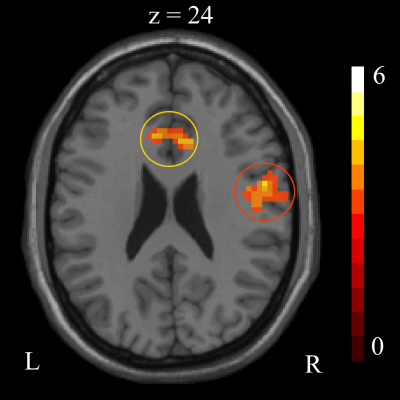4644
Altered brain activation during cognitive control in children with enuresis1College of Medical Imaging, Shanghai University of Medicine&Health Science, Shanghai, China, 2Department of Developmental and Behavioral Pediatrics, Shanghai Institute of Pediatric Translational Medicine, Shanghai Children’s Medical Center, Shanghai Jiao Tong University School of Medicine, Shanghai, China, 3MOE‑Shanghai Key Laboratory of Children’s Environmental Health, Shanghai Jiao Tong University School of Medicine, Shanghai, China, 4Shanghai Key Laboratory of Magnetic Resonance and Department of Physics, School of Physics and Materials Science, East China Normal University, Shanghai, China
Synopsis
This study was to investigate the potential disturbance in cognitive control in enuretic children using functional MRI. Two groups including enuretic and healthy children were scanned during a color-word Stroop task to evaluate their task performance and neural response. Compared to the healthy subjects, the children with enuresis showed stronger Stroop effect and increased activation for the incongruent > congruent condition contrast in the anterior cingulate and the precentral/postcentral gyri. Our results suggested that the enuretic children showed altered neural responses to conflict events and tended to compensate by greater activation to sustain normal cognitive control.
INTRODUCTION
Enuresis involves involuntary voiding during sleep and is a common disorder in school-aged children that affects about 10% of 7-year-old children.1 Enuresis should not be considered as a voiding disorder alone. It has reported that the patients exhibited abnormal brain response patterns to response inhibition and working memory.2 Facing the choice between urinate and keep urine can be considered processing a conflict event. The Stroop task is widely used in cognitive control study, and subjects exhibit interference in the conflict condition through longer reaction times and more errors.3 The aim of this study was to investigate the potential disturbance in cognitive control in enuretic children using functional magnetic resonance imaging (fMRI) in combination with a Stroop task.METHODS
In this work, we used fMRI with a color-word Stroop task to evaluate brain response changes in enuretic children. Two groups, one consisting of 16 elementary-aged children with enuresis and one with 12 healthy children were scanned using fMRI. Functional images were acquired by using an EPI sequence with the following parameters: TR/ TE = 2000 ms/ 30 ms. In the Stroop task, four color words (red, green, yellow, blue) were displayed pseudo-randomly in the congruent or incongruent color. Participants were instructed to name the color of the stimulus by pressing the corresponding button as soon as possible, while ignoring the word. The task contained 2 runs and each run contained 4 blocks (the ratio of two conditions is 1:1).Task performance scores (incl. mean reaction time –RT, performance accuracy and Stroop interference effect [incongruent_minus_congruent for RTs]) were calculated and compared between groups. For fMRI data, BOLD signals between the task conditions (congruent, incongruent) were contrasted using a general linear model. Brain activation differences during these contrasts between groups were determined by independent two-sample t-tests. Statistical maps were considered to be significant at a family-wise error corrected cluster significance threshold of p <0.001 (surpassing a peak level p<0.001 initial voxel threshold). Within the clusters observed in the between-group comparison of incongruent_minus_congruent contrasts, the mean activation values were extracted for each contrast to perform post hoc tests.
RESULTS
There were no differences between the enuretic group age (M = 9.4 years, SD = 1.5 years) and the healthy group (p > 0.05). Significant differences were found between congruent and incongruent stimuli in RTs and accuracy respectively in the patients but not in the healthy group. We did not found any between-group differences in RTs and accuracy respectively, while Stroop effects in the enuretic children were stronger than the healthy (see Figure 1).Several brain regions exhibited increased activation in the patients in the whole-brain analysis for the incongruent > congruent condition contrast, including the bilateral anterior cingulate cortex (ACC) and the right precentral/postcentral gyri (see Figure 2). The extracted activation values in ACC were associated positively with the Stroop effect.
DISCUSSION
Previous studies have indicated that the ACC plays an important role in conflict monitoring, executive control and response selection.3 Precentral/postcentral gyri are known as primary motor and somatosensory cortex, belonging to the sensorimotor network.4 The hyperactivation of these brain regions indicated that the enuretic children might exhibited altered patterns during cognitive control. Besides, we found both the stronger Stroop effect in the patients and the positive correlation between activation of ACC and Stroop effects. The evidence supported that these regions were involved in the Stroop interference. The performance data was in line with the fMRI data. Therefore, when the enuretic children were faced with the cognitive conflicts, they may need more effort associated with cognitive and sensorimotor function as compensation, in order to achieve the equal level of task performance.CONCLUSION
Our results suggested that the children with enuresis showed altered neural responses to conflict events and tended to compensate by greater activation in ACC and precentral/postcentral gyri to sustain normal cognitive control. Larger samples and different subtypes of enuresis are needed to validate the results. This result might give clues to understanding the pathophysiology of enuresis.Acknowledgements
This work was supported by grants from the National Natural Science Foundation of China (Nos. 81571658 to Xiaoxia. Du, and Nos. 81901720 to Mengxing Wang)References
1. Riccabona M. Evaluation and management of enuresis. An update. Urologe A. 2010; 49(7):861.
2. Zhang K, Ma J, Lei D, et al. Task positive and default mode networks during a working memory in children with primary monosymptomatic nocturnal enuresis and healthy controls. Pediatr Res; 2015.
3. Swick D, Jovanovic J. Anterior cingulate cortex and the Stroop task: neuropsychological evidence for topographic specificity. Neuropsychologia. 2002; 40(8):1240-1253.
4. Zhang J, Su J, Wang M, et al. The sensorimotor network dysfunction in migraineurs without aura: a resting-state fMRI study. J Neurol. 2017; 264(4):654-663.
Figures

